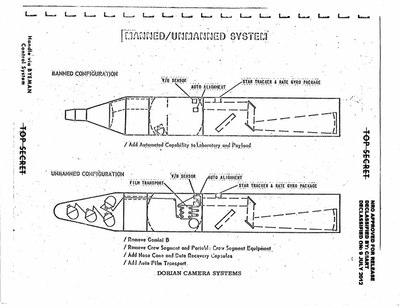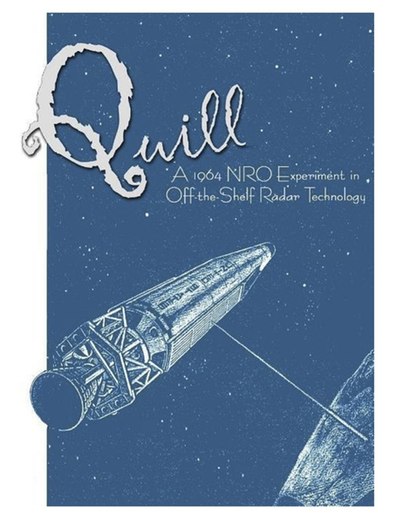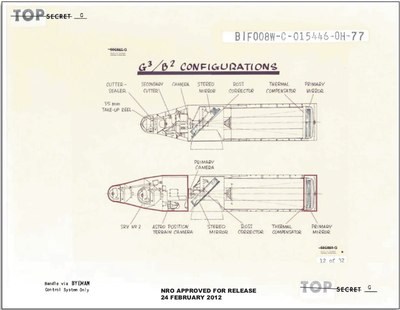Revelationsby Dwayne A. Day
|
 A declassified document shows a concept for an unmanned version of DORIAN, aka the MOL. (larger version) |
A short time later, the NRO declassified a lengthy history of the POPPY signals intelligence satellite program. POPPY operated from the mid-1960s until the late 1970s and its existence was first declassified in 2005. Relatively little information on POPPY was released seven years ago, and relatively little has been released since then. The NRO did acknowledge that POPPY was eventually adapted for detecting vessels at sea, but was remarkably obtuse about its technology. The newly declassified history, however, is full of details, although significant amounts of technical information, such as the frequencies it detected, have been omitted. Perhaps the most surprising revelation about POPPY was that right from the first launch in 1962 POPPY was a multi-satellite system. Exactly how this worked remains unclear, but POPPY apparently increased its effectiveness by using several satellites to take multiple bearings on a signal emitted by a radar, like the classic direction finding technique developed during the Second World War. The first POPPY launch involved two satellites, and some of the later ones involved up to four.
The NRO made some further surprising revelations in July when it declassified substantial documents and several official histories of the QUILL radar satellite program. Three QUILL satellites were built, but only one was launched in December 1964. QUILL was remarkably successful, taking the relatively new technique of synthetic aperture radar (SAR) into space. SAR works by taking multiple radar images of a target from a moving vehicle and essentially superimposing them upon each other to build up a more detailed image than conventional radar. Although QUILL flew at a much higher altitude than the aircraft that were then starting to operate with synthetic aperture radars, the satellite proved to be a better platform because it had no vibration and it traveled in a straight line. Although QUILL was highly successful, it was only a test program, and it appears as if its utility was sufficiently limited that the intelligence community did not return to SAR in space for a couple of decades.
 A declassified document about QUILL, a radar satellite program. |
Along with the QUILL documents was another small tidbit about MOL: an illustration of its internal layout, as well as confirmation of the fact that as early as 1965 the NRO was evaluating how to take the “M” out of “MOL” by developing an unmanned version of the DORIAN system. The illustration of this unmanned version is probably preliminary and it is possible that the actual unmanned design, if it continued to progress before the entire program was canceled in summer 1969, looked more like the similarly-sized HEXAGON camera system with its four film return vehicles.
In late July the NRO released a few additional documents about the GAMBIT and HEXAGON programs, including new versions of the official histories that were first declassified in September 2011. There are a number of interesting revelations within these documents, although two notable ones are an illustration of the dual platen developed for GAMBIT-3 satellites in the 1970s that allowed it to take two images simultaneously (not previously released), and an Eastman Kodak briefing document from 1977 that describes the overall GAMBIT-3 system, including its manufacture. The Kodak document also includes a nice illustration of the early and later GAMBIT-3 satellites that depicts the addition of a second film return vehicle as well as some other internal changes. For a spy satellite buff, this is akin to learning about the differences between, say, a B-52B Stratofortress bomber and the B-52H that eventually succeeded it.
This tremendous amount of information released in the past year is credit to an impressive declassification program within the intelligence services. The US military and intelligence space programs during the first couple of decades of the space age can now be described in incredible detail and understood far better than before. This will enable historians to better understand their role in the Cold War, their importance to arms control, and their linkages to other aspects of American space technology. These declassifications leave relatively little that is still classified from the first decade of American space intelligence. One notable omission is much detail about the small signals intelligence satellites developed by the US Air Force and flown from the 1960s all the way into the 1980s. But given the recent releases, it is entirely possible that we may soon know about their work as well.
